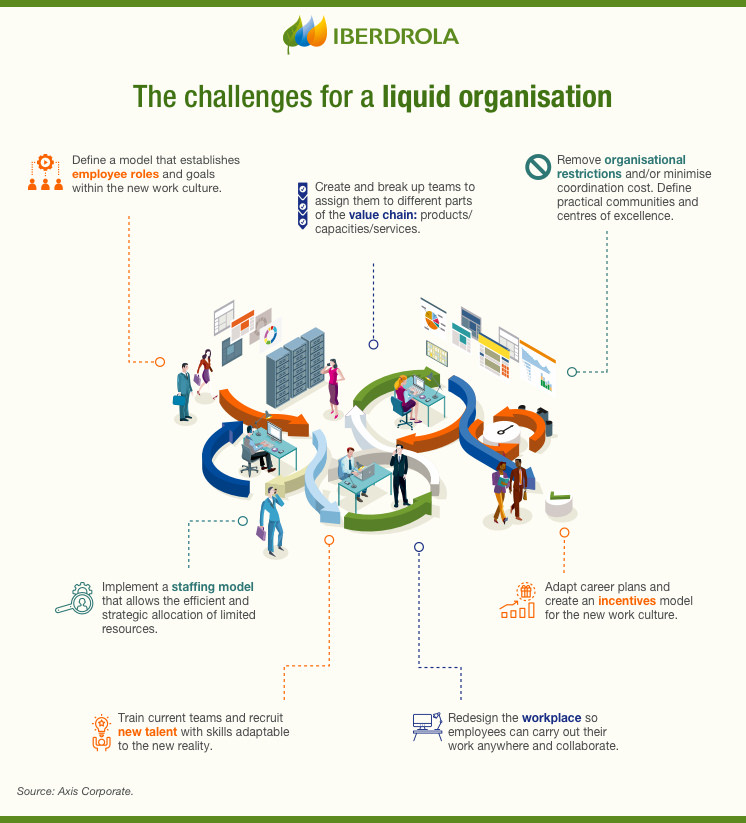Liquid organisations
The path towards becoming a liquid organisation is marked by an 'agile' culture
In a fast-evolving digital world, agility and flexibility in tackling tasks and projects is the key to success. But how is this achieved? By implementing a different way of organising and working. This is where an agile culture comes in, as it improves productivity and encourages the development of liquid organisations.

Fast as the wind, flexible as reeds, adaptable as water. Put rather poetically, this could be a summary of what an agile organisation is considered to be today. Agility is, without doubt, the star trait that companies seek to achieve, a concept imposed by digital transformation that entails an essential change in business culture for all those organisations wishing to adapt and progress in this new era.
What is a liquid organisation. Characteristics
A liquid organisation is one that seeks ever faster responses to a world that is evolving at great speed and, consequently, it is one that develops an adaptive capacity allowing it to modify structures and roles flexibly to exist in a state of permanent change, while also encouraging cooperation between employees. Although the concept sounds thoroughly modern, and it is, its origin is now a couple of decades old. In 1999, Polish sociologist Zygmunt Bauman coined the concept liquid modernity to define a type of society based on fluidity.
In a liquid organisation the structures are flexible and horizontal, meaning that the hierarchy is less marked than in a traditional company. They are usually made up of multidisciplinary teams that work on projects and are then dissolved once the objectives are achieved. In addition, the working method is faster and more transparent: they avoid the bureaucracy that hinders decision-making, communication flows in every direction, fixed physical jobs are diluted and schedules are more flexible, thus encouraging teleworking.
Beyond all this, the most important factor is human capital: people are the centre of the company and therefore the search for and retention of talent are a constant. In fact, these organisations' employees, who must also be liquid, are recognised not so much by the position they occupy, as by their capabilities.
Tips for being a liquid organisation. 'Agile', the key methodology
How can an organisation become liquid? The way forward is marked by companies that have been liquid since their creation and they are mostly found in the technology sector. An example is the music streaming multinational Spotify, that based its model on aspects including: adapting to the changing needs of the business, adjusting processes to any new ways of working and by substituting the usual hierarchy for structures called squads, tribes, chapters and guilds to manage the teams. For other companies, those that are not naturally liquid, the answer may be to adopt an agile model External link, opens in new window..
The agile concept emerged at the end of the twentieth century in the world of software in response to the concerns of various leaders in this industry who saw the development of projects being excessively delayed, with the consequent economic loss. This gave rise to the Agile Manifesto, and it is a methodology that has transformed the culture of thousands of companies. Experts in the field point out that an agile culture is one that embraces an agile way of being and thinking, which affects both strategy and structures and processes with one ultimate goal: to be more flexible and productive, while generating well-being among employees.
Adopting an agile culture involves a transformation process that, according to the consultancy McKinsey & Company External link, opens in new window., affects the following areas:
External link, opens in new window., affects the following areas:
 Structure
Structure
Staff numbers and location model, reporting structure (simplify and eliminate levels), roles and responsibilities, management (streamline decision making).
 Processes
Processes
Team processes (free up time to devote to actions that generate value), liaison mechanisms, planning and decision processes, performance management.
 Technology
Technology
Support systems and tools that underpin the new method, evolving architecture, execution pipeline, IT infrastructure and applications able to support rapid changes.
 People
People
Leadership (train managers to inspire rather than lead), talent management, communications networks (create organic networks in the organisation).

BENEFITS OF BEING A LIQUID ORGANISATION
Being a liquid organisation does not ensure success, but it does have a number of advantages that can put the company on the right track. Let's take a look at some of them:
- Optimised structures and cost savings. Teams are made and dissolved according to the needs of the company, which avoids having inoperative and unproductive staff.
- Easier adaptation. These organisations have the ability to continuously adapt to customers' needs and their business environment, since their structures are flexible.
- Facilitated decision-making. The working method, based on experimentation, provides constant knowledge that facilitates more flexible and rapid decision-making.
- Promotion of innovation. Their flexible structure allows them to launch innovations with fewer obstacles, which is why they are a constant source of creativity.
- Cooperation between employees. Their structure helps to eliminate organisational barriers, which generates a more collaborative environment between professionals of different profiles.




